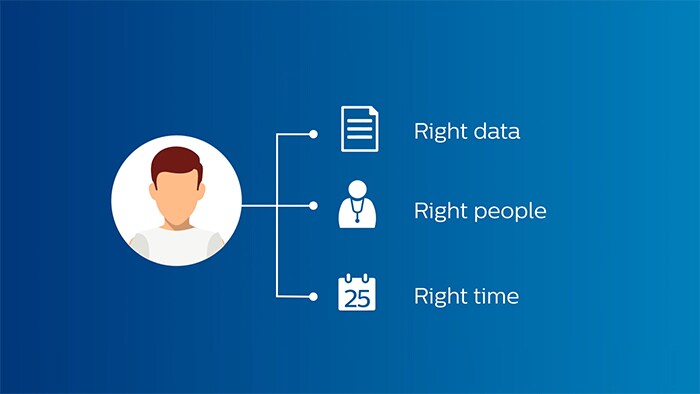Informatics
What if your hospital systems exchanged data seamlessly?

Healthcare leaders cite lack of interoperability as a top barrier to adopting digital health technologies, second only to budgetary contraints.1 The growing emphasis on efficiency, quality of care, cost control and access by patients to their own clinical information requires greater cooperation among systems and caregivers. The use of multiple systems from multiple vendors calls for a strategic approach that includes standards-based interoperability to realize the promise of seamless health information exchange. Interoperability allows for the secure flow of data and a consistent user experience across the entire healthcare continuum while embracing vendor neutrality. Connecting systems, hospital departments and care pathways enables a more complete view of the patient’s health. True interoperability has the power to break down barriers in patient handoffs, disparate technologies, inefficient workflows, siloed data among departments and providers, along with unwarranted variations in treatment selection. The goal is patient-centric care through harmonious collaboration, enabling clinicians to become more effective in delivering precision care, and patients to become more actively involved in their own care.
Healthcare professionals want access to all relevant information about their patients, seamlessly accessible from their electronic health record (EHR) system. Every stakeholder along the clinical pathway needs this access for a longitudinal view of the patient.
At a glance
Challenge
The rise of connected medical devices and the hidden pockets of unstructured data they generate contribute to a lack of interoperability among multiple, incompatible hospital systems, frustrating healthcare professionals. Interoperability must be addressed in order to use data for a complete view of the patient, allowing for a confident diagnosis and care plan.
Results
An enterprise-wide interoperability strategy overcomes barriers, ensuring that insight-rich data is put to meaningful and appropriate use, connecting people with the right data at the right place and the right time for confident care. An effective interoperability strategy goes beyond a purely technical context to provide a seamless, flowing user experience. Thoughtfully implemented, interoperability has the power to improve human interaction by creating an enhanced, collaborative environment.
Additional resources
Share this article
How do we create a 360-degree view of the patient for all stakeholders?

Data standardization and EHR interoperability—layered with real-time indications of a patient’s admit, discharge, and transfer status and with timely clinical documentation retrieval—are key ingredients for a successful, patient-centered approach. An interoperable software system helps consistently and optimally capture, index, manage, store, distribute, view, exchange and analyze all clinical imaging and multimedia content to provide a 360-degree view of the patient in the EHR. Empowering your teams with this helps them enhance patient outcomes, improve patient and provider experiences and reduce costs via centralized data management.
While achieving true interoperability is a complex endeavor, its goal is simple: allow the right data to reach the right people at the right time, keeping the patient at the center of care.
Detangle the data to streamline processes
Many organizations are pursuing an interoperability platform that is a scalable, modular software cloud-based solution grounded in the technical framework of Integrating the Healthcare Enterprise (IHE), which allows healthcare enterprises to connect information systems in a state-of-the-art infrastructure for sharing medical data. Be sure to look for a partner who can help you accomplish the transition from on-premises to cloud-based IT in a responsible way.
Consider components that work together as a suite of software products or independently to interface with any cross-enterprise-document-sharing (XDS) infrastructure. This allows for the indexing and storing of all available medical data (non-DICOM and metadata) in the interoperability platform to keep data accessible and never bound to a single vendor.
Clinical information tagged by well-defined metadata describing clinical content means that medical documents and images can be electronically exchanged within the healthcare enterprise. It’s important that the platform be not merely agnostic with regard to content and vendor, but that it is also multi-vendor positive. This provides the opportunity for healthcare providers to share and exchange clinically relevant information to support better-informed clinical decisions, for example, by creating a longitudinal patient view.
It’s vital to give data access to all who need it, when and where they need it. Only when you can see everything can you start to solve anything.
Clinical information only becomes useful if it is transformed into structured data that can be used within context. The challenge of intelligently mining and harnessing an exponentially expanding volume of structured and unstructured data is ongoing, as is the desire for security and scalability when managing data across the enterprise for end-to-end interoperability. Look for a partner who can help you align the priorities that are unique to your organization while helping you advance your digital imaging strategy.
Share this article
At a glance
Challenge The rise of connected medical devices and the hidden pockets of unstructured data they generate contribute to a lack of interoperability among multiple, incompatible hospital systems, frustrating healthcare professionals. Interoperability must be addressed in order to use data for a complete view of the patient, allowing for a confident diagnosis and care plan.
Results An enterprise-wide interoperability strategy overcomes barriers, ensuring that insight-rich data is put to meaningful and appropriate use, connecting people with the right data at the right place and the right time for confident care. An effective interoperability strategy goes beyond a purely technical context to provide a seamless, flowing user experience. Thoughtfully implemented, interoperability has the power to improve human interaction by creating an enhanced, collaborative environment.
Additional resources
Want to learn more about interoperability?
Discover our user-friendly, clinically proven portfolio of integrated diagnostic informatics solutions.
1. The age of opportunity: empowering the next generation to transform healthcare. The Future Health Index 2020, a proprietary report commissioned by Philips.
